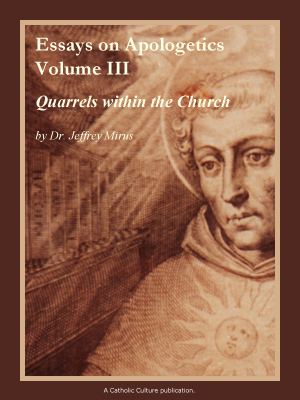The Priest Shortage;: Natural Or Man-(And Woman-) Made?
Over the past two decades or so, Catholics in the U.S. have grown accustomed to hearing about a "vocations crisis" in their Church. The number of priests has been in decline, while the number of laity has continually risen. The conventional wisdom -- articulated by fashionable theologians and angry feminist nuns -- has been that the solution to the crisis is to ordain women to the priesthood. In response to these aggressive assertions, the Holy See made it absolutely clear that the Church has no authority to ordain priestesses. In 1994 Pope John Paul II issued his apostolic letter Ordinatio Sacerdotalis, and the Congregation for the Doctrine of the Faith issued its 1995 Responsum ad Dubium. These acts made it an infallible declaration of the ordinary Magisterium that God's plan for His Church does not include ordination of women: never has, never will. The critics, however, continued unabated; in fact, they became more strident in their demands.
Then, within the past year or two (depending on which sources you read) a funny thing happened: The numbers of seminarians and recent ordinations increased -- not only throughout the world (which was nothing new), but in the U.S. itself, and that was news. The increase was noted not only by the Catholic press, but by the secular press, such as The New York Times and USA Today.
Unfortunately, for many Catholics a priest shortage continues at their local level. Many parish rectories are understaffed; in many dioceses there are few priests (who are terribly overworked). Thus, while the statistics indicate an increase, it still feels like a shortage to many practicing Catholics -- which raises the question: Is there or isn't there a famine of priestly vocations at this time? The answer depends largely on your geographical location. That is so largely because of the policies of local bishops. And so, if you are a Catholic in America today, where you live is perhaps the best predictor of vocational abundance or scarcity.
Dioceses headed by bishops with a reputation for robust orthodoxy now have full seminaries and an abundance of seminarians. Witness Denver under Archbishop Chaput (and Cardinal Stafford before him), Peoria under Bishop Myers, New York under Cardinal O'Connor, and Lincoln under Bishop Bruskewitz, to name a few. It is dioceses like these that are now causing the upward trend in vocations, more than counterbalancing the paucity in other locations. Meanwhile, those dioceses headed by more "liberal" bishops are characterized by a decline in vocations -- sometimes sharp -- and in some cases actual closings of parishes. Currently this is occurring in Milwaukee under Archbishop Weakland; Saginaw, Michigan, under Bishop Untener; and Los Angeles under Cardinal Mahony. In the early 1990s this pattern was evident in San Francisco under Archbishop Quinn, and Chicago under Cardinal Bernardin (where, despite Bernardin's high profile in the national prestige press, parish closings in his own back yard sparked bitter local protests). The formula appears simple: "Conservative" (i.e., "pro-Roman") bishop equals abundance of new priests; "liberal" (Le., "Americanized") bishop equals shortage of vocations and ordinations.
Moreover, those religious orders that are known for their "traditionalism" and discipline are attracting many young applicants and are growing rapidly, while those who appear "stuck in the Sixties," with a feminist/liberal ideology, are declining and dying out. Witness the rapid growth of the Missionaries of Charity, the Oblates of Mary Immaculate, Opus Dei, and the Legionaries of Christ, to name a few. Similar trends are evident among Protestant churches as well: The mainline bodies (Episcopal, Presbyterian, Methodist) that have become the most trendy are dying out, while the Evangelical communities (where pastors insist on the importance of doctrine and preach a strongly "biblical" Christianity) are growing. Again, the formula seems evident: Following society's trends (sexual laxity, feminism, selfism) equals decline in the religious arena.
One of my acquaintances has given me permission to describe the details of his experience as an applicant for priestly training, on condition that his name not be used. He graduated from a Catholic university in 1989, and later applied to the major seminary of his diocese. Before he went for the interview, he had been "briefed" by two priest friends on the politically correct (read, feminist) answers he needed to give to get through the screening process. In the course of his interview, the nun who was screening him made him wait while she took a phone call In the course of her conversation -- while my friend sat patiently -- she stated to the party on the other end of the line that she fully expected to be wearing a priest's stole and celebrating Masses soon. She also showed my friend a birthday card she had recently received which had a humorous yet clearly "anti-male" (his words) message. He was also asked searchingly if he had ever attended Mass at a certain Catholic college known for its orthodoxy. Her tone, he said, clearly indicated what his answer should be.
He actually made it through the screening process and was accepted. But so disheartened was he at what had happened (both the nun's bullying, and his own acquiescence and evasiveness) that he did not begin studies at the seminary.
Two other young men I know applied at the same seminary. One was accepted and began studying, but was asked to leave before his first year of studies was completed. He is not sure why, but thinks his preference for the Tridentine Mass and praying the Rosary may have had something to do with it. My other friend is a student there now, but the last time I talked to him, he told me he was thinking about transferring to the seminary of another diocese where the bishop has a reputation for strong orthodoxy. In addition to these personal acquaintances, I have heard of at least one student who left that seminary in disgust and entered a religious order, and of another who left under similar circumstances and is now a happily functioning priest of another diocese. What these men, and very likely scores of others like them, have in common is a traditional sensibility and piety (not unlike the Holy Father's), and a clear sense that they were not satisfactorily "progressive" for those in charge of the seminary. Perhaps they were too fond of the Rosary, or disagreed with the latest editorial in the National Catholic Reporter (the "in" paper at the seminary), or defended the Holy Father's decree on the ordination of women.
Here a dark suspicion arises: Is the apparent failure of some dioceses to attract and ordain new priests actually a desired outcome for those in charge? If the local bishop appoints to high positions in the diocese persons who favor certain radical non-Catholic changes, such as the ordination of women, is it surprising that the number of new priests goes down, that the applicants are found unsuitable if orthodox, and that the calls to ordain women increase? In other words, the same leadership that created the shortage now uses that shortage to cry out for priestesses. Indeed, this is exactly what Archbishop Elden Curtiss of Omaha has said.
The situation bears all the marks of dogmatic feminism. Feminism begins by denying male headship--in the family or the Church--and ends by decrying the lack of males (in the home or the seminary), which it caused. If it is true that behind every good man is a good woman, it is perhaps equally true that behind many an absent man is a spiteful feminist. The dearth of vocations in some dioceses may have been what certain highly placed feminists in the Church (and those bishops who dance to their tune) had as part of their agenda all along.
And so, while there are dramatic increases in those cities where the bishop is vigorously orthodox, the tragedy continues in others, where the bishop's associates are feminists to a man, or at least go along with the feminist agenda.
I am glad when I hear positive reports about vocations from various dioceses, and I attribute the positive changes to the steadfastness of a certain man in Rome. I attribute the upswing in vocations to the bishops he has appointed (even if some have been disappointments). If your diocese now has a full seminary, and your local parish or diocese suffers no priest shortage, chances are you have Pope John Paul II to thank. You have often heard it said that we must pray for vocations. While this is correct, it would also be wise to pray for the conversion of those present stumbling blocks to men who consider priestly vocations. And, if your diocese is not one of those partaking in the current feast, one recourse you have is to write to the Holy Father and request his help to correct abuses in your diocese: Pope John Paul II, Apostolic Palace, 00120 Vatican City, Europe.
If your diocese has plenty of vocations, you might want to pray for those Catholics who suffer a priestly famine in the midst of your feast.
Larry A. Carstens teaches English in a public high school and holds a Master's Degree in English literature. His first book, God Rules: the Commandments, the Beatitudes and the Virtues for Teens and Young Adults is available from God Rules: the Website.
© New Oxford Review, 1069 Kains Ave., Berkeley, CA 94706, 510-526-5374.
This item 2949 digitally provided courtesy of CatholicCulture.org






